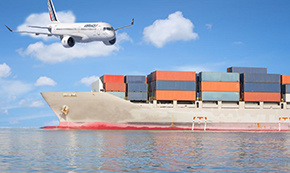Declaration of dangerous goods
We provide special customs clearance services for dangerous goods. Unlike ordinary goods, dangerous goods require special modes and conditions of transport. Dangerous goods in air transport refers to all goods that are explosive, flammable, toxic, corrosive, radioactive, etc., and require special protection during transportation, handling and storage, which are likely to cause personal injury or death and property damage.
Category of hazardous materials.:
1. Explosives refers to the products that can make explosion and create violent chemical reaction, instantaneous generation of large amounts of gas and heat, and the surrounding pressure rises sharply external action (such as heat, impact, etc.) under the use of external force. The export cargo mainly contains fireworks and firecrackers etc. Operators should check test reports and approval certificates when receiving explosives.
2. Gas contains flammable and explosive gases (e.g., butane, propane, lighters), non-flammable, non-toxic gases (e.g., carbon dioxide, neon, fire extinguishers, cryogenic liquefied gases) and toxic gases. In addition, it also contains aerosol or aerosol sprayers. Sprayers are non-refillable containers made of metal, glass or plastic. These containers are filled with compressed, liquefied or pressurized dissolved gas which allows the contents to be ejected as solid or liquid particles. It is worth noting that most toxic gases are prohibited by air, with only a few exceptions, e.g., low-toxicity aerosols, tear gas devices.

3. Liquids contains flammable liquids (e.g. certain paints, varnishes, alcohols, adhesives, acetone, gasoline) and viscous substances (e.g. paints, varnishes, lacquers, adhesives, polishes).
4. Flammable solids, spontaneously combustible substances and solid substances that emit flammable gases in contact with water.
5. Oxidizing agents (e.g. calcium chloroform, potassium permanganate, bleach) and organic peroxides that can be ignited by an open flame and burn rapidly.
6. Toxic products (e.g. arsenic, nicotine, oxides, pesticides) and infectious substances (e.g. viruses, bacteria, saliva containing viruses, medical waste).
7. Radioactive substances (e.g. radium 226, natural uranium, luminous powder, luminol) are classified as primary, secondary and tertiary radioactive substances according to their radioactivity).
8. Corrosive substances (e.g. sulphuric acid).
9. Miscellaneous dangerous goods. Refers to articles which create a hazard in air transport, but which are not included in the first 8 categories, and which may be of a narcotic, irritating or other nature that may cause annoyance or discomfort to passengers (e.g. asbestos, garlic oil, lifeboats, internal combustion engines, vehicles, electric wheelchairs, aviation life-saving equipment).
Items filled with flammable gases or liquids that may emit small amounts of flammable gases (e.g., polychlorinated ethylene pellets, semi-finished polymer materials); solid carbon dioxide (e.g., dry ice, frozen vegetables, ice boxes and ice cream); magnetic substances (e.g., magnetoelectric tubes, unshielded permanent magnets, neodymium boron). Responsible parties should prohibit transporting the dangerous goods by air
Export process for dangerous goods:
1. Take orders for booking
Provide us with the export consignment note 7-10 days in advance, indicating the name, container type, dangerous goods class (CLASS), UN NO., dangerous package, and special requirements in English and Chinese to facilitate the application of space and dangerous goods declaration.
2. Provision of declaration information
Provide information related to the declaration of goods four working days in advance:
① Dangerous goods packaging performance test result sheet
② Dangerous goods packaging use identification results sheet
③ Product description: Chinese and English
④ Export declarations (a. Write-offs b. Invoices c. Packing sheet d. Customs commission sheet e. Export declarations
3. Container and port
Since dangerous goods are loaded straight on the ship's side, they are usually boxed 3 days before the ship departs
① The shipper will deliver the goods to our designated dangerous goods warehouse for internal loading.
② Our company will arrange the trailer to the factory for packing, after packing, we need to put the big danger mark around the container, and if the goods will cause sea pollution when leaking, we also need to put the sea pollution mark, and also take photos for evidence.
4. Customs declaration
Determine the container number, vehicle tonnage, inventory, and complete customs declaration documents and start exporting customs declaration, which will be released after customs examination and approval.
5. Bill of lading confirmation
Create the bill of lading according to the power of attorney and confirm the bill of lading with the customer to ensure the authenticity and accuracy of the bill of lading content.
6. Payment
Confirm fee bills with customer and collect related fees.
7. Return customs declaration and waybill
Return the customs declaration to the customer for tax refund write-off about one month after the export declaration is completed.
Logistics Query
Quickly obtain the latest logistics information
Scan code contact
Address: 25/F Room C,Tower A, Honglong Century Plaza, No. 4002 Shennan East Road,Luo Hu District, Shenzhen, China
Zhongshan Address: Room 805, Floor 8 , Poly Plaza office Building, No. 1 Shiji East Road, Port Town, Zhongshan, Guangdong
Changsha Address: 12020, Building 2, Fudi Xingguang Tiandi, Yuhua District, Changsha .,Hunan
Indonesian company:PT VTOP LOGISTIK INTERNATIONAL
Indonesian address:Jalan Pantai Indah Barat Komplek Toho Blok A No 18 ,Kec.Penjaringan,Kel.Kamal Muara,Jakarta Utara

WeChat ID

Scan code contact









